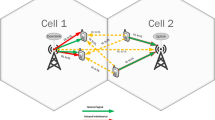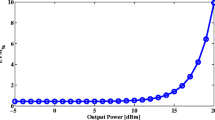Abstract
In this paper, we present a novel non-iterative coordinated beamforming algorithm for overlaid multicell coordinated beamforming systems where a macro base station acts as an anchor and computes the beamforming vectors. We propose beamforming vector design that improves the received signal-to-interference-plus-noise-ratio while reducing the computational complexity. We also show its asymptotic behaviors with respect to the number of antennas, confirming that the proposed solutions are useful for large-scale multiple-input multiple-output systems in heterogeneous and small cell networks.







Similar content being viewed by others
References
Belschner, J., Rakocevic, V., & Habermann, J. (2018). Complexity of coordinated beamforming and scheduling for OFDMA based heterogeneous networks. Wireless Networks,25, 2233–2248.
Boukhedimi, I., Kammoun, A., & Alouini, M. S. (2017). Coordinated slnr based precoding in large-scale heterogeneous networks. IEEE Journal of Selected Topics in Signal Processing, 11(3), 534–548.
Brown, D. R., & Love, D. J. (2014). On the performance of mimo nullforming with random vector quantization limited feedback. IEEE Transactions on Wireless Communications, 13(5), 2884–2893.
Chae, C. B., Heath, R. W., Jr., & Mazzarese, D. (2006). Achievable sum rate bounds of zero-forcing based linear multi-user mimo systems. In Allerton conference on communication control and computing (pp. 1134–1140).
Dai, W., Liu, Y., & Rider, B. (2008). Quantization bounds on Grassmann manifolds and applications to mimo communications. IEEE Transactions on Information Theory, 54(3), 1108–1123.
Farhang-Boroujeny, B., Spencer, Q., & Swindlehurst, L. (2003). Layering techniques for space-time communication in multi-user networks. IEEE Vehicular Technology Conference, 2, 1339–1343.
Horn, R. A., & Johnson, C. R. (1990). Matrix analysis (4th ed.). New York: University of Cambridge Press.
Karakayali, M., Foschini, G., & Valenzuela, R. (2006). Network coordination for spectrally efficient communications in cellular systems. IEEE Transactions on Wireless Communications, 13(4), 56–61. https://doi.org/10.1109/MWC.2006.1678166.
Lakshminarayana, S., Assaad, M., & Debbah, M. (2015). Coordinated multicell beamforming for massive mimo: A random matrix approach. IEEE Transactions on Information Theory, 61(6), 3387–3412.
Love, D. J., & Heath, R. W, Jr. (2005). Limited feedback unitary precoding for spatial multiplexing. IEEE Transactions on Information Theory, 51(8), 2967–2976.
Pan, Z., Wong, K. K., & Ng, T. S. (2004). Generalized multiuser orthogonal space-division multiplexing. IEEE Transactions on Wireless Communications, 3(6), 1969–1973.
Peel, C. B., Hochwald, B. M., & Swindlehurst, A. L. (2005). A vector-perturbation technique for near capacity multiantenna multiuser communication—part I: Channel inversion and regularization. IEEE Transactions on Communications, 53, 195–202.
Santipach, W., & Honig, M. L.: Asymptotic performance of mimo wireless channels with limited feedback. In IEEE military communications conference (Vol. 1, pp. 141–146). IEEE (2003)
Santipach, W., & Honig, M. L. (2009). Capacity of a multiple-antenna fading channel with a quantized precoding matrix. IEEE Transactions on Information Theory, 55(3), 1218–1234.
Schubert, M., & Boche, H. (2004). Solution of the multiuser downlink beamforming problem with individual sinr constraints. IEEE Transactions on Vehicular Technology, 53(1), 18–28.
Simeone, O., Somekh, O., Poor, H. V., & Shitz, S. S. (2009). Local base station cooperation via finite-capacity links for the uplink of wireless networks. IEEE Transactions on Information Theory, 55(1), 190–204.
Tervo, O., Pennanen, H., Christopoulos, D., Chatzinotas, S., & Ottersten, B. (2018). Distributed optimization for coordinated beamforming in multicell multigroup multicast systems: Power minimization and sinr balancing. IEEE Transactions on Signal Processing, 66(1), 171–185.
Yoo, T., & Goldsmith, A. (2006). On the optimality of multiantenna broadcast scheduling using zero-forcing beamforming. IEEE Journal on Selected Areas in Communications, 24(3), 528–541.
Zhong, Z., Peng, J., & Huang, K. (2017). Analysis on physical-layer security for multi-cell coordination aided ultra-dense heterogeneous networks. IEICE Transactions on Communications, 100(10), 1846–1855.
Zhou, L., Zheng, L., Wang, X., Jiang, W., & Luo, W. (2017). Coordinated multicell multicast beamforming based on manifold optimization. IEEE Communications Letters, 21(7), 1673–1676.
Acknowledgements
The authors would like to thank Dr. Insoo Hwang for discussion and constructive comments. This work was supported in part by the Institute of Information & Communications Technology Planning & Evaluation (IITP) through the Korea Government (MSIT) (Supervised Agile Machine Learning Techniques for Network Automation based on Network Data Analytics Function) under Grant 2019-0-00024, and in part by the National Research Foundation of Korea (NRF) through the Korea Government (MSIT) under Grant NRF-2020R1A2B5B01002528.
Author information
Authors and Affiliations
Corresponding author
Additional information
Publisher's Note
Springer Nature remains neutral with regard to jurisdictional claims in published maps and institutional affiliations.
Rights and permissions
About this article
Cite this article
Kwon, M., Park, H. Non-iterative Coordinated Beamforming for Multicell MIMO Heterogeneous Networks. Wireless Pers Commun 112, 763–775 (2020). https://doi.org/10.1007/s11277-020-07072-0
Published:
Issue Date:
DOI: https://doi.org/10.1007/s11277-020-07072-0




